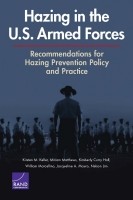| 来源类型 | Research Reports
|
| 规范类型 | 报告
|
| ISBN | 9780833090270
|
| 来源ID | RR-941-OSD
|
| Hazing in the U.S. Armed Forces: Recommendations for Hazing Prevention Policy and Practice |
| Kirsten M. Keller; Miriam Matthews; Kimberly Curry Hall; William Marcellino; Jacqueline A. Mauro; Nelson Lim
|
| 发表日期 | 2015
|
| 出版年 | 2015
|
| 页码 | 146
|
| 语种 | 英语
|
| 结论 |
The Department of Defense (DoD) Definition of Hazing Can Be Improved- The definition should include qualities that distinguish hazing from other types of abuse and mistreatment.
- It should clarify the role of authority figures and the individual's responsibility.
- It should consider the addition of more objective terms in describing harm, such as "psychological injury" or "extreme mental stress" and provide current examples.
The Effects of and Motivations for Hazing Need to be Addressed- Among other things, proponents of hazing argue that acts of hazing or harsh initiation rituals contribute to increased liking of, commitment to, and cohesion within the group.
- However, evidence for these different effects is mixed, and research and reports demonstrate that hazing can lead to physical and psychological injuries among hazees.
DoD Does Not Currently Have a Clear Understanding of the Scope of the Hazing Problem- Once the department has a clear definition of hazing and is able to uniformly track hazing incidents and better assess scope, it can then better determine whether to invest in a DoD-wide database system or whether service-level tracking remains sufficient.
- Elements DoD should consider tracking include victim and perpetrator characteristics, location, circumstances, types of behavior, and incident severity.
- Confidential or anonymous surveys should be used to supplement reported incident databases to give a more-comprehensive assessment of hazing across the services.
|
| 摘要 |
- At the organizational level, efforts to address hazing should include providing a clear definition that distinguishes hazing from other forms of abuse and mistreatment, communicating antihazing policies and consequences, holding leaders accountable, ensuring that there are options for anonymous reporting, and implementing comprehensive assessment of hazing through standardized tracking of reported incidents and anonymous surveys.
- At the individual level, efforts should include a training sequence that increases knowledge, influences attitudes and perceptions, and changes or develops behaviors and skills and teaching leaders to identify and address hazing.
|
| 主题 | Crime and Violence Prevention
; Military Education and Training
; Organizational Leadership Development
; Sexual Assault
; United States Department of Defense
; Workplace Violence
|
| URL | https://www.rand.org/pubs/research_reports/RR941.html
|
| 来源智库 | RAND Corporation (United States)
|
| 资源类型 | 智库出版物
|
| 条目标识符 | http://119.78.100.153/handle/2XGU8XDN/108125
|
推荐引用方式
GB/T 7714 |
Kirsten M. Keller,Miriam Matthews,Kimberly Curry Hall,et al. Hazing in the U.S. Armed Forces: Recommendations for Hazing Prevention Policy and Practice. 2015.
|
|
文件名:
|
x1499092318352.jpg
|
|
格式:
|
JPEG
|

|
文件名:
|
RAND_RR941.pdf
|
|
格式:
|
Adobe PDF
|
除非特别说明,本系统中所有内容都受版权保护,并保留所有权利。